“Just give it a go!”—taking on the challenge of the most advanced research on Venus, earthquakes, and geothermal power generation
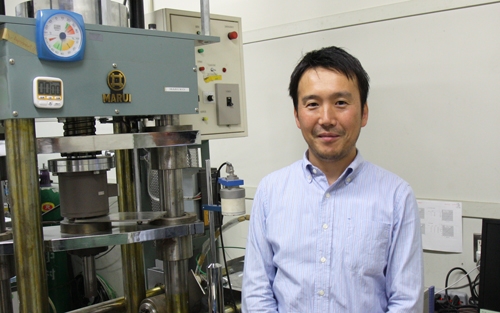
We talked to Associate Professor Ikuo Katayama, Department of Earth and Planetary Systems Science, Graduate School of Science.
(Interview: June 10, 2014, by PR Group)
Introduction
Associate Professor Katayama has been engaged in research on mobile belts, ranging from rock deformation experiments and field surveys to earthquake research. With his motto of “Just give it a go!” he has achieved various research results to date.
One of his achievements is a new theory on Venus that he released in March 2014, in joint names with Shintaro Azuma, then third-year student in the Ph.D. program in the Graduate School of Science (already graduated from the school at the time of writing), and others, which explained that the reason for the absence of plate tectonics* on Venus is attributed to its inner viscosity structure.
On Earth, sea formation and the creation of life occurred thanks to the work of plate tectonics. It is expected that, if the reason for the lack of plate tectonics on Venus is revealed, we can make new insights into the reason why Earth and Venus have a similar size but look totally different as well as into the evolution of other planets and the presence of life on them.
This theory was covered by Scientific Reports, an online scientific magazine by Nature Publishing Group, U.K. (Click here for the article.)
*Plate tectonics: a scientific theory which explains that more than ten plates which constitute the Earth’s surface are floating on the convecting mantle
In addition to the above, Associate Professor Katayama studies other topics, including earthquakes and geothermal power generation. In this interview, we asked him about his current research and what he values as a researcher.
Research on focal mechanism stemmed from rock deformation study
Associate Professor Katayama’s specialist field of research is rock deformation study, and now he conducts research on focal mechanisms. How are rocks related to earthquakes?
He answers, “The Earth is made of rocks. Temperature at its surface is about 20°C and it becomes higher the deeper it gets inside, reaching 6,000°C in some parts. This high temperature melts the rocks into thick, syrup-like liquid and it slowly flows around. We believe that this flow has a close relationship with phenomena on the surface of the earth, including earthquakes and volcano eruptions. In this context, we mainly study the fluidity of rocks, conducting experiments in which we replicate the condition inside the Earth by applying high temperature and pressure to the rocks collected in volcanos and around the plates.”
By pursuing the focal mechanisms from the viewpoint of rocks flowing inside the Earth, he tackles the question of when and where an earthquake will happen.
Earthquakes induced by water!?
Generally, it is said that earthquakes are caused by the force generated when a plate pulled by another plate is returning to its original position.
Associate Professor Katayama says, “I believe many people have seen a 2D diagram explaining plates. However, plates in the real, 3D world have various types of interfaces between each other. In some areas, plates are locked together, but in others, they are not solidly connected and are sliding away against each other. An earthquake happens when those plate interfaces that are supposed to be locked together are slipping.”
How could those solid plates become apt to slip? To our surprise, he points out that water is one of the causes.
“Actually, three to four times as much water as all the seawater in the world is contained inside the Earth in the form of hydroxyl in rocks, etc. In addition, laboratory experiments have already proved that rocks become apt to slip when there is water. Based on these facts, we are exploring the focal mechanisms by analyzing the water distribution and location of the points where water is pooled inside the Earth.”
He also tells that there are some interesting cases in the past concerning the relationship between earthquakes and water.
“In Italy, there was an earthquake following the construction of a dam and storing of water. It broke down the dam and devastated the villages along the river. Also, there is a report of a case from the 1960s in which frequent earthquakes hit the surrounding areas of the points where the U.S. forces injected contaminated water underground for disposal. In both cases, water seems to have something to do with it.”
Associate Professor Katayama’s research is vital to earthquake prediction and disaster risk management. At the same time, it reminds us of the fact that we are living amidst a subtle balance on the Earth.
How could those solid plates become apt to slip? To our surprise, he points out that water is one of the causes.
“Actually, three to four times as much water as all the seawater in the world is contained inside the Earth in the form of hydroxyl in rocks, etc. In addition, laboratory experiments have already proved that rocks become apt to slip when there is water. Based on these facts, we are exploring the focal mechanisms by analyzing the water distribution and location of the points where water is pooled inside the Earth."
He also tells that there are some interesting cases in the past concerning the relationship between earthquakes and water.
“In Italy, there was an earthquake following the construction of a dam and storing of water. It broke down the dam and devastated the villages along the river. Also, there is a report of a case from the 1960s in which frequent earthquakes hit the surrounding areas of the points where the U.S. forces injected contaminated water underground for disposal. In both cases, water seems to have something to do with it.”
Associate Professor Katayama’s research is vital to earthquake prediction and disaster risk management. At the same time, it reminds us of the fact that we are living amidst a subtle balance on the Earth.
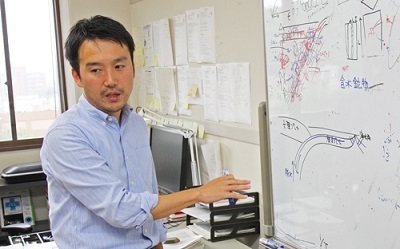
Associate Professor Katayama giving an explanation using a whiteboard
Also tackling geothermal power generation!
Besides the exploration of focal mechanisms, Associate Professor Katayama has recently started research on geothermal power generation. Why geothermal power generation?
He says, “Petroleum will likely be exhausted in about 40 years. Other fossil fuels will also be depleted in about 120 years. In this context, expectations for renewable energies* including wind power, solar power, and geothermal power are growing, although the supply of such energies still remains low. Among others, I especially focus on geothermal power generation. This is because my research on water distribution, fracture and slip of rocks inside the Earth is intimately related to geothermal power generation.”
*Renewable energies: energies that can be produced from natural phenomena and can be used semi-permanently
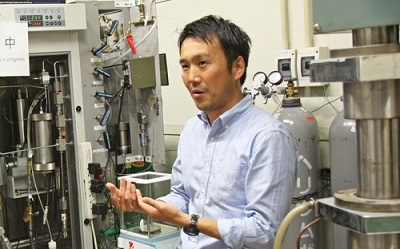
Associate Professor Katayama explaining the reasons why he started his research on geothermal power generation
Associate Professor Katayama explains the merits of geothermal power generation as follows.
“I believe that a geothermal power plant will be able to steadily supply a certain volume of power regardless of seasons and time, once the facilities are established. Japan, the land of volcanos, has magma in the deep underground and there is enormous heat energy. A geothermal power plant extracts and utilizes this energy in the form of water vapor. Another merit of geothermal power generation is its eco-friendliness – it emits less CO2 (one twentieth of thermal power generation). Geothermal power generation alone may cover the world’s whole energy consumption if technology development for efficient energy extraction is advanced in the future.
He says he is particularly interested in enhanced geothermal system (EGS), among others.
“EGS is a power generation method which artificially establishes a water circulation system by injecting water underground. This method allows power generation without natural hydrothermal resources and dramatically expands exploitable areas.”
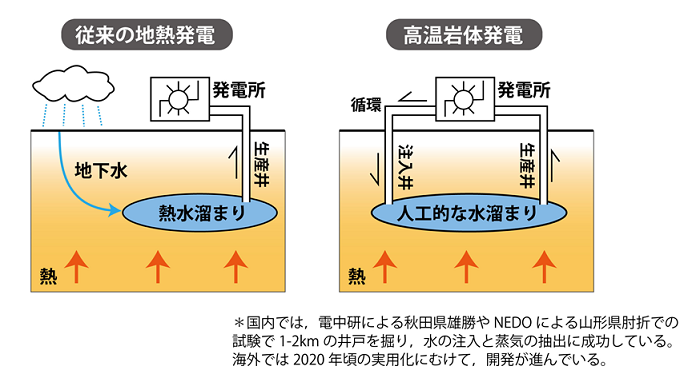
While EGS offers many benefits, it also has some disadvantages such as low energy recovery efficiency and the possibility of inducing an earthquake caused by hydraulic fracturing.*
He expresses his future ambition as follows. “I would like to solve the issues by utilizing the technologies and other achievements that I have cultivated in my earthquake research so far and put EGS into practical use.”
*Hydraulic fracturing: small cracks on rocks formed by pressurized water pushing out the rocks
“Just give it a go!” – earth and planetary systems science is a field where you can try anything.
Associate Professor Katayama describes himself as “a kind of person who cannot do anything when thinking too much.” Knowing his own character very well, he has chosen a motto of “Just give it a go!” He says that, in the world of research, there are many things that you never know until you really try yourself.
“Even when you look at a paper and you think at first glance that there is nothing left to study on the topic, a reproductive experiment might produce a different result, and in some cases there is no reproducibility at all. So you never know until you really try. ‘Make a move before thinking too much’ – this is my style for research.”
He says his motto of “Just give it a go!” fits the earth and planetary systems science field very well.
“I imagine that I could better deal with details if I immersed myself in a specialized field. I also think it would possibly feel more comfortable. However, earth and planetary systems science is a fusion of geology, mineralogy, physics and chemistry, with a focus on the Earth. For this reason, I have to hungrily learn about the fields other than my specialized field, which leads me to learn more and more and inspires me to apply such learning to my own research.”
Making a new discovery “is so exciting that I can’t sleep”
He says that he feels most rewarded when he discovers something new.
“I think it is the most exciting and enjoyable moment when you feel like ‘I am the only one who knows about this in this whole world,’ which I guess is a common feeling for all researchers. It makes me so excited that I can’t really sleep!” he laughs.
He says to reveal something that no one has ever tried to is the most enjoyable part of science.
Giving an example showing that even outstanding Nobel-winning basic research can take 30 years until finally being applied to various analyses and contributing to society, he explains his future prospects as follows.
“Sometimes, something that was believed capable of contributing to a limited field becomes beneficial to other fields or even to the whole of society. I’m trying to pay attention to research that is not needed so much in the present society so that I will not kill their future potential. At the same time, I would like to continue to produce research results that can return the benefits to today's society, like I have done so far.”
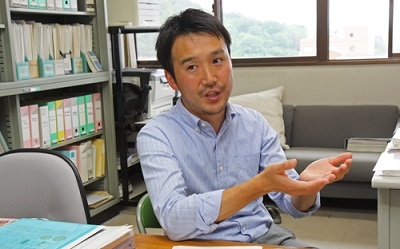
Associate Professor Katayama explaining the joy of making a new discovery
Afterword
Associate Professor Katayama said that his initial motivation to start learning about earth and planetary systems science was rather ambiguous—he “only wanted to know what was happening on the Earth.” I saw that his curiosity to learn and his attitude of “let’s try it” led to his new research results. While he values his own feelings, he also sincerely says “I want to fulfill my curiosity but at the same time I also want to focus on something that is beneficial to society.” As I became familiar with the passionate personality of Associate Professor Katayama and the profoundness of the Earth, I started to feel like majoring in earth and planetary systems science if I ever get the chance to go to university again. (i)
Associate Professor Katayama will give a lecture at the Sekigaku evening course (lecture for working people)
Date and hour: October 31, 2014 (Fri.) 18:30–20:30
Title: “Water Is the Root of the Earth”
Content: Water is a vital matter to the Earth, as with water to life. In addition to its existence in the surface sea and air, circulation of the water inside the Earth will be also explained.
*Click here for application (Japanese Page)


 Home
Home

